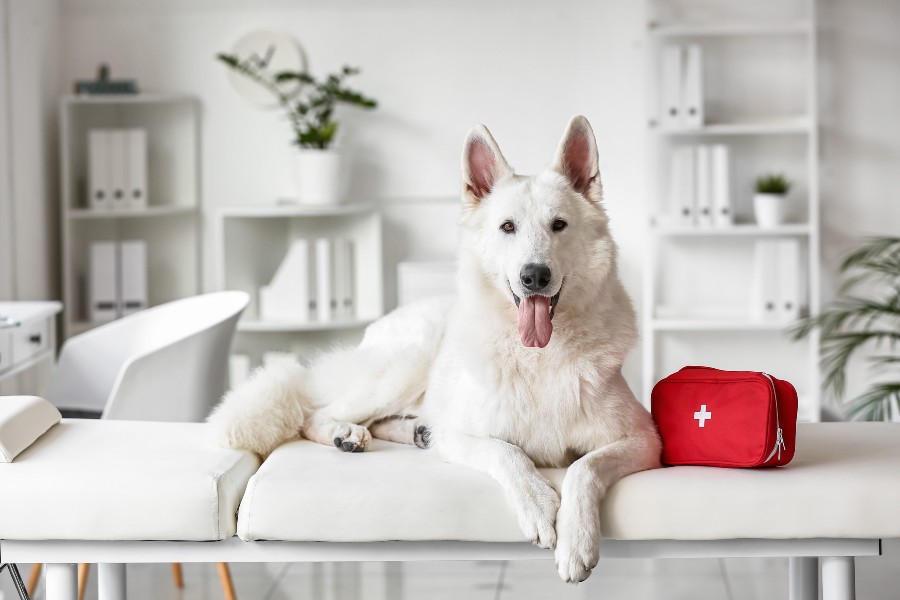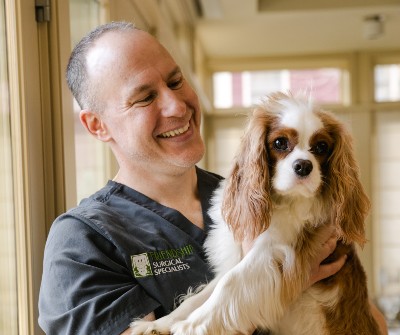Building Your Pet’s Medicine Cabinet: A Veterinary Surgeon’s Guide

DogFoodAdvisor is reader supported See how
Dog Food Advisor is 100% impartial and is never paid to promote any brand. But if you buy using links on this page, we may earn a referral fee.
Have you noticed that it’s become harder to get to a vet? The surge in people getting pets, unsurprisingly, hasn’t been matched by an increase in the number of veterinarians.
Demand is outstripping supply and, according to some, this imbalance will get worse — Mars Petcare predicted a shortage of 24,000 veterinarians in the U.S. by 2030.
So, what can you do? One thing is to assemble a ‘pet medicine cabinet’. By that, we mean gather at home a host of items that could help you in an emergency.
We asked veterinary surgeon Dr. Mat Glassman, the CEO and founder of Dr. Cuddles, to put together a guide to creating a pet medicine cabinet and a list of items you could or should have at home.
Here’s what he wrote…

How to Create a Pet Medicine Cabinet
As a veterinary surgeon with 20 years of veterinary experience, I’ve seen my fair share of emergencies and health issues in pets, ranging from mild upset stomachs and cuts and scrapes to severe cases of intoxication and traumatic injuries.
One thing that consistently proves invaluable in managing these situations is a well-prepared pet medicine cabinet. Today, I want to guide you through setting up a comprehensive medicine cabinet that could save your pet’s life or prevent a minor issue from escalating.
Understanding Your Pet’s Needs
The first step in building your pet’s medicine cabinet is to understand the specific needs of your pet. This involves more than just knowing what to keep on hand for emergencies. You should consider your pet’s age, existing health conditions, where you live, and any regular medications they may require.
For instance, a bulldog living in Arizona needs to have a plan and supplies that could help with overheating; while pet owners that do not live within 20 minutes of an accessible veterinarian, should 100% have an oral detoxifier at home for their pet in the case the pet is poisoned.
What You Need in a Pet Medicine Cabinet
First Aid Supplies
In addition to medications, your cabinet should include basic first aid supplies:
- Telfa Pad or non-adherent dressing/wound pads
- Cotton Roll for covering and protecting wounds (and keeping the non-adherent dressing on the wound).
- Roll Gauze to help keep the cotton intact
- Non-stick, Cohesive Bandage Material (sticks to itself) to use as a breathable protective layer.
- Veterinary Note: It is important to remember that when bandaging, we walk a fine line between bandages not falling off and bandages cutting off circulation. Finding the sweet spot takes practice for even the best veterinary professional. This means that these home bandages should be temporary and you should make sure that they are not causing sores or swelling that could be significantly worse than what you are trying to protect and clean
- Medical Tape to help maintain a bandage.
- Digital Thermometer: To check your pet’s temperature. Remember, the normal body temperature for dogs and cats ranges from 101 to 102.5 degrees Fahrenheit. You can use a digital thermometer rectally, or you can use an ear thermometer or infrared thermometer. If going with the latter options, I recommend checking your pet’s temperature when they are not sick to know the normal reading for your pet with that specific device.
- Scissors and Tweezers: For cutting bandages or removing splinters. A good pair of bandage scissors are key. Don’t skimp here or you will not be happy with yourself when you need them in a crunch.
- Nail Trimmer: Oftentimes when an animal rips a nail off, clipping the excess off can help them be more comfortable.
- Elizabethan Collar: It is important to keep your pet from licking or chewing at their wound (we don’t need their help). Although some feel that saliva of the dog is helpful for healing, it isn’t and it is full of harmful bacteria. Having an Elizabethan collar on hand is best practice.
Essential Over-the-Counter Medications and Medicated Topicals
Some over-the-counter medications can be safely used for pets, but always consult your veterinarian first (especially if your pet is on other drugs that in theory could interact with these over the counter medications). Here are a few staples:
- Cetirizine (Zyrtec): Similar to Benadryl, this is an antihistamine useful for allergic reactions. Dosage is 1 mg/lb given up to twice a day.
- Omeprazole (Prilosec): A stomach acid reducer that is safe and can help dogs that have upset stomach or are not eating. 2-4 mg/lb once a day
- Eye Flush – for those potential scratches and infections that result in eye squinting. A soothing eye flush that is antimicrobial is ideal. I recommend our Dr. Cuddles Heal-at-home Eye Flush, as it’s safe, gentle and antimicrobial.
- Ear Cleanser– Ear cleanser that is gentle and non-desiccating (drying)- I recommend our Dr. Cuddles Heal-at-home Ear Care+ which has hypochlorous acid as the antimicrobial agent and can also be used for facial folds and other applications.
- Wound Treatment: For minor cuts and scrapes, ensure it’s a pet-safe brand without additional pain relievers. I recommend hypochlorous acid based as used in our Dr. Cuddles Heal-at-home Wound Gel, as it is natural, safe and effective.
Detoxification and Emergency Treatments
One absolute must-have in your pet’s medicine cabinet is something to save your pet when they accidentally eat something they shouldn’t. Think grapes, raisins chocolate, human medications, THC, onions etc. All pet owners should have an oral detoxifier like ReadyRESCUE™ which is an advanced form of activated charcoal that is compact, clean and dense making it ideal for administering at home in an emergency.
ReadyRESCUE™ is designed to help with pet intoxication by binding with various toxins, which are then expelled through the stool. It’s a critical first aid tool that can buy you crucial time while you triage and seek veterinary assistance.
Alternatively, hydrogen peroxide can be used to induce vomiting. I’m not a fan of hydrogen peroxide as it cannot be used in cats, can cause burns in the stomach and esophagus of dogs(Niedzwecki, 2017), and is inconsistently effective — studies show, it only works to bring up half of the toxin 60% of the time (Khan, 2012).
Prescription Medications
If your pet is on prescription medications, always keep a current supply PLUS a small cushion of extra. This includes anything they take regularly for chronic conditions such as heart disease, kidney disease, or thyroid issues.
Ensuring you have backup on hand allows you a safety net should your pet run out or you lose some medications. I also recommend having a backup plan for obtaining more medications when needed. Remember, your vet needs to see your pet a minimum of once a year in order to legally prescribe your pet medications.
Gastrointestinal Support
Pets often get into things that are not necessarily toxic, but don’t agree with them, resulting in upset stomachs or worse. Diarrhea is not ideal in any household and having some things on hand to help with that is highly recommended. Key items include:
- Probiotics: These can help maintain intestinal health. I recommend Visbiome to help restore normal gut health.
- Pumpkin: Plain canned pumpkin (not pie filling) is great for digestive irregularities (i.e. diarrhea or constipation oddly). The fiber in the pumpkin helps to move things along, or soak up extra fluid to make diarrhea less messy.
- Antidiarrheal Medications: Immodium AD is a reasonable OTC to have on hand for some animals if used in 1-2 doses to treat diarrhea. However, it is important to know that it cannot be given to cats and collies as it can have significant side effects. Dosage is 0.5 mg per 10lbs given up to twice a day.
Pain Relief
Never give human pain relievers like ibuprofen or aspirin to pets without a veterinarian’s direct approval. Ibuprofen is very harmful for their kidneys. Aspirin has a low therapeutic index, meaning, there is a low margin for safety and should never be used in cats. Instead, ask your vet about prescribing a pain medication such as Rimadyl that is safe for your pet in case of acute pain or injury.
Flea, Tick, and Parasite Control
Always have an effective flea and tick prevention method on hand (I recommended a monthly dosage option). If you are in an endemic area or have a population of resistant fleas or ticks, consider a tick collar or ask your veterinarian to prescribe some Capstar for you to have on hand for your pet. Capstar is an oral pill that kills fleas and ticks immediately. Always use heartworm prevention to guard against heartworms and gastrointestinal parasites.
Contact Information
Keep a list of important phone numbers: Your vet, the nearest emergency vet clinic, and a poison control center that handles pet cases. If you are out of town, always tell the person that is pet sitting your animals what to do in case of emergency. I recommend discussing a maximum amount of money that can be spent if there is a life-threatening emergency and you are unable to be contacted.
Storage and Maintenance
Store all pet medications and supplies in a cool, dry place out of reach of pets and children. Near your human medicine cabinet is a safe bet. Regularly check expiration dates and replace any expired medications.
Conclusion
A well-stocked medicine cabinet is an essential part of pet care, acting as your first line of defense in many emergency situations or simply when managing minor health issues at home. Always discuss any new medications or treatments with your veterinarian to ensure they are safe and appropriate for your pet’s specific health needs- especially if your pet is on chronic medication or has chronic health conditions. Remember, timely intervention can make all the difference in the world, when it comes to helping your pet in an emergency.
References
Niedzwecki, A. H., Book, B. P., Lewis, K. M., Estep, J. S., & Hagan, J. (2017). Effects of oral 3% hydrogen peroxide used as an emetic on the gastroduodenal mucosa of healthy dogs. Journal of veterinary emergency and critical care, 27(2), 178-184.
Khan, S. A., Mclean, M. K., Slater, M., Hansen, S., & Zawistowski, S. (2012). Effectiveness and adverse effects of the use of apomorphine and 3% hydrogen peroxide solution to induce emesis in dogs. Journal of the American Veterinary Medical Association, 241(9), 1179-1184.
Final word
The Dog Food Advisor does not accept money, gifts, samples or other incentives in exchange for special consideration in preparing our reviews.
However, we do receive a referral fee from online retailers (like Chewy or Amazon) and from sellers of perishable pet food when readers click over to their websites from ours. This helps cover the cost of operation of our free blog. Thanks for your support.
For more information, please visit our Disclaimer and Disclosure page.



